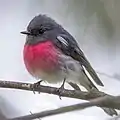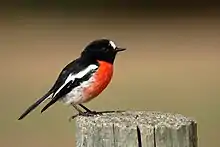| Petroica | |
|---|---|
 | |
| North Island robin (Petroica longipes) | |
| Scientific classification | |
| Domain: | Eukaryota |
| Kingdom: | Animalia |
| Phylum: | Chordata |
| Class: | Aves |
| Order: | Passeriformes |
| Family: | Petroicidae |
| Genus: | Petroica Swainson, 1829 |
| Type species | |
| Muscicapa multicolor[1] Gmelin, 1789 | |
| Species | |
|
14; see text | |
Petroica is a genus of Australasian robins, named for their red and pink markings. They are not closely related to the European robins nor the American robins.
The genus was introduced by the English naturalist, William John Swainson, in 1829, with the Norfolk robin (Petroica multicolor) as the type species.[2][3] The generic name combines the Ancient Greek petro- "rock" with oikos "home".[4]
Many species in Australia have a red breast and are known colloquially as "red robins" as distinct from the "yellow robins" of the genus Eopsaltria.[5]
Species and subspecies
The genus contains the following 14 species:[6]
| Male | Female | Common name | Scientific Name | Distribution |
|---|---|---|---|---|
 |  | Rose robin | Petroica rosea | Australia. |
 | Pink robin | Petroica rodinogaster | Tasmania, southern Australia | |
| Snow Mountains robin | Petroica archboldi | West Papua, Indonesia. | ||
| Mountain robin | Petroica bivittata | New Guinea Highlands | ||
 | _(17191139570).jpg.webp) | Flame robin | Petroica phoenicea | south-eastern Australia, including Tasmania |
| Solomons robin | Petroica polymorpha | Solomon Islands. | ||
 | Pacific robin | Petroica pusilla | Melanesia and Polynesia. | |
_in_the_Norfolk_Island.jpg.webp) | Norfolk robin | Petroica multicolor | Norfolk Island, an Australian territory in the Tasman Sea, between Australia and New Zealand | |
 |  | Scarlet robin | Petroica boodang | Australia, including Tasmania. |
 | _female_(14403872754).jpg.webp) | Red-capped robin | Petroica goodenovii | Australia. |
 | .jpg.webp) | Tomtit | Petroica macrocephala | New Zealand |
 | North Island robin | Petroica longipes | North Island of New Zealand. | |
 | South Island robin | Petroica australis | New Zealand | |
 | Black robin | Petroica traversi | the Chatham Islands | |
References
- ↑ "Pectroicidae". aviansystematics.org. The Trust for Avian Systematics. Retrieved 2023-07-16.
- ↑ Swainson, William John (1829). Zoological illustrations, or, Original figures and descriptions of new, rare, or interesting animals. Series 2. Vol. 1. London: Baldwin, Cradock. Plate 36 text.
- ↑ Mayr, Ernst; Cottrell, G. William, eds. (1986). Check-list of Birds of the World. Vol. 11. Cambridge, Massachusetts: Museum of Comparative Zoology. p. 562.
- ↑ Jobling, J.A. (2019). del Hoyo, J.; Elliott, A.; Sargatal, J.; Christie, D.A.; de Juana, E. (eds.). "Petroica". Handbook of the Birds of the World Alive: Key to Scientific Names in Ornithology. Lynx Edicions. Retrieved 17 June 2019.
- ↑ Dowling DK (2003). "Breeding biology of the red-capped robin". Australian Journal of Zoology. CSIRO Publishing. 51 (6): 533–549. doi:10.1071/ZO03028. Retrieved 2007-06-07.
- ↑ Gill, Frank; Donsker, David, eds. (2019). "Australasian robins, rockfowl, rockjumpers, Rail-babbler". World Bird List Version 9.2. International Ornithologists' Union. Retrieved 17 June 2019.
- Del Hoyo, J.; Elliot, A. & Christie D. (editors). (2006). Handbook of the Birds of the World. Volume 12: Picathartes to Tits and Chickadees. Lynx Edicions. ISBN 978-84-96553-42-2
Further reading
- Kearns, A.M.; Malloy, J.F.; Gobbert, M.K.; Thierry, A; Joseph, L.; Driskell, A.C.; Omland, K.E. (2019). "Nuclear introns help unravel the diversification history of the Australo-Pacific Petroica robins". Molecular Phylogenetics and Evolution. 131: 48–54. doi:10.1016/j.ympev.2018.10.024. PMID 30367975.
External links
This article is issued from Wikipedia. The text is licensed under Creative Commons - Attribution - Sharealike. Additional terms may apply for the media files.